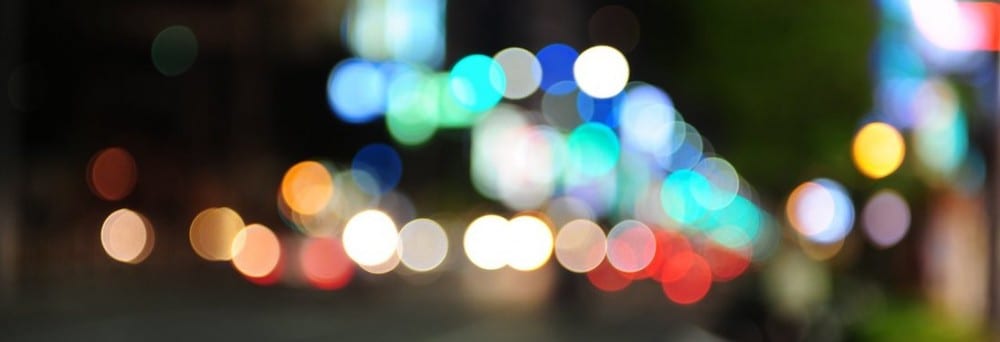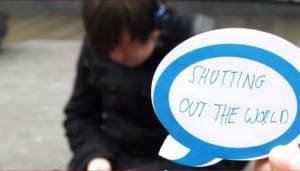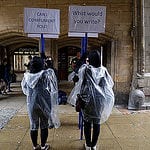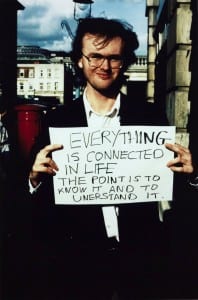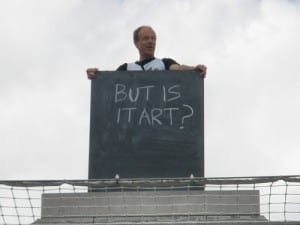Framing Statement:
The aim of the high street these days is too make consumers spend money; we want to stop this with social interaction by breaking everyday routines even if it is only for a fleeting moment.
The word ‘Liberation’ was the starting block to our performance; we were asked what it meant to us in the context of our site: ‘The High Street’. After discussing the high street with not only our group but with others as well, it became clear that the main aim is to spend money. This led to a discussion on how we could change this, however we knew that we would never put a stop to it outright, this is where the concept of a ‘fleeting moment’ came from . We wanted to create a piece that would not only disrupt the flow of the high street in the moment of interaction but would also make the audience think about it later. This is part of the reason we used simple interactions, ones that people use in everyday life. However the context of the simple interactions, made them feel abnormal. It’s not everyday that you walk through the high street and are confronted by 4 girls wearing ponchos and sunglasses holding giant signs asking to be hugged or give high fives.
Our performance took place on Thursday 7th May between the hours of 11am and 1:30pm, the signs were spread across the length of the high street, we had four in total each had a different message: ‘can we hug?’, ‘can we high five?’, ‘can I compliment you?’ and ‘what would you write?’, these signs were printed on A2 signs that were 3 foot high so could be seen all the way down the high street. The order of the signs was important; we started at the bottom of the high street with the sign that needed the least interaction (compliment) and ending at the top of the high street with the sign that require the most social interaction (what would you write?). The objective of the performance was to allow social interaction, this is why it was imperative that we were inviting, meaning that we had to look happy whilst stood with our signs, this was then juxtaposed every half an hour with the ‘changing of the guard’. Based on the formal ritual performed outside Buckingham Palace, we marched to the stone bow for a rehearsed changing over. This juxtaposition highlighted the fact that it was a performance, and also tied our performance in with work by other performance artists like Andrew Stitt, Gillian Wearing and the work that took place during the Happenings.
Analysis Of Performance:
Our piece took heavy influence from quite a lot of other performance art work. We looked into many different practitioners throughout the module however we were influenced heavily by just a few. Whilst researching the use of signs in site based performance work, we came across a piece of work by Gillian Wearing called signs that say what you want to say and not what someone else wants you to say. It was one of her earlier works and involved members of the public holding up signs that they had written something on. Early on in the process we looked into Wearing’s work, just as inspiration for the audience interaction portion of our project. I personally felt that I was very much the same as Wearing at the beginning of her work; I was nervous about approaching strangers however as Wearing said “once I actually got the statement out… I’d say 85% of the people said yes“ (Wearing,1999,) this was the same with our performance. In test runs, we did it with smaller versions of our signs, people had a tendency to complete the action on the sign when prompted but never really knew why they were doing it. As a group we tried to explain, but as we hadn’t produced a prepared speech the answers varied between performers, which is not something we could afford on the day. The performance’s message about the liberation of consumerism would not be effective if an audience member heard 4 different versions of our aim. This is why we decided early on in the process that we needed a framing statement for the piece, one that as actors, the four of us could learn, and would describe concisely and clearly our aims for the performance.
Drifting was a big part of the whole process, we read sardine street box of tricks, this highlighted the fact that location is important to a performance. ‘you need to be hyper-sensitised to the flows, stories and textures of what is around you’ (Crab man& Signpost, 2011). I use the high street every day and until I did my first drift from St Mary Le Wigford right up to the Cathedral I had never noticed many of the things that it contained. We decided to drift individually before meeting at the bottom of Steep Hill before continuing to the top as a group. The top still being the optional site for our performance at this point. As Lincoln is one of the oldest cities in the country dating back to the roman times there were a lot of interesting things to see, however the thing that struck us most as a group was the misplacement of a single brick in the path. This one brick being slightly out of place highlighted the idea that small changes can make a big difference. The idea that one brick could change the look of the whole street was mesmerizing to me, it made me contemplate the idea of loneliness and how something that has been out-cast can be forgotten about so easily, just like a non-consumer is on the high street.
The process started with exploration on Tim Ettchell’s 8 Fragments, whilst reading this the one that stuck out to us a group the most was observation/ coincidence. In this section Ettchell’s states “we pass each other like objects on a projection line.” (Etchells, 1999, 79). It was after we spent time observing the high street as bystanders we realised how true this was. Lincoln High Street is the epitome of a production line created by large shopping corporations, consumers walk from one to the other rarely stopping, with the one goal, to spend money. This is where the beginnings of our idea came to fruition. We knew we wanted to challenge social stereotypes and defy the rules liberating not only ourselves but the consumer as a whole from the restraints of a consumerist society.
This led to one of our first experiments in our site. We took the idea of a production line and looked at it literally taking inspiration from things like escalators; ‘on an escalator we watch each other, getting closer, and then just as we could speak, or even touch, our eyes drop and the moment passes (Etchell 1999, 79). People passed one another mechanically. We wrote messages such as ‘can we high five?’ on post-it-notes and held them out, whilst traveling in opposite directions to people on the escalators. The aim was to take people out of their comfort zone, it also broke the anonymity people hide behind whilst by themselves when on the high street. By breaking the usual flow of the escalator we changed the function just for a fleeting moment, Pearson states that “In public, we may require a kind of physical restraint, a kind of decorum that allows the mass to function” (Pearson, 2010, 98). By approaching strangers with a request to take part in a simple action that was already familiar to them, we stopped them from being taken out of their comfort zone too much, meaning they were more likely to engage in the practice making audience interaction more likely.
DominqueGent,2015
We not only engaged with the audience we also used observation to look at people on the high street ‘the city was always about glimpsing other lives?’ (Etchell, 1999,79). This is why we used the post-it-notes in order to make snap judgments about members of the public, we documented this through the use of photography much like Gillian Wearing does with her pieces. This task allowed us to look at people we would usually ignore whilst on the high street. What was most interesting about this task is that throughout the whole process we were mostly ignored, people were disinterested in what we were doing choosing instead to carry on with their daily routines. Whilst doing this activity we noticed a man handing out fliers, after watching him for twenty minutes we noticed that nearly everyone that walked passed him ignored him. Due I believe to the fact that on the high street people are pre programmed to believe that everyone is trying to sell them something. This led to the interesting notion of gifts and how that man could have been handing out anything, but as people have a preconceived notion of leaflet givers have ignored his plight to help people. This concept interested us, as we wanted to try and find something that would pull people out of there own worlds for long enough for them to notice their surrounding, and have a chance to change their opinions on the high street and its purpose in modern society.
Although part of the brief for frequency festival is pervasive media we decided it was important to steer intentionally away from it. We noted from our trips to the site that whether it was people making phone calls, sending/receiving texts, listening to music or doing other things, mobile phones have become a staple of modern day life, leading to the lack of attention people pay to one another increasing. During our final performance I had a conversation with a lady who said “I think it is appalling that young people are always on their phones, they are missing everything”. This statement is for the most part true; however it is not just young people technology has also gripped the older generation. Whilst carrying out our first test, I saw an equal number of people over the age of 30 on their phones as I did teenagers. The aim of our piece was to make people notice what was around them, by doing this it was clear that pervasive media was not an option for us to fully reach our goal.
After our first experiment we were quite set on the idea of giving gifts, we then sat down and wrote a list of possible gifts we could give to passers by that would disrupt the flow of their journey, however the act of gift for even a short period of time would then resonate with them for the rest of the day. We then settled on just five that we could take onto the high street in a series of trial runs.
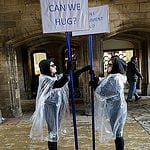
P, Crowe, 2015 Changing of the guard Taken 7th May 2015
We found was that ‘ Can we high-five?’ and ‘Can we hug?’ were by far the most popular. However, the most interesting reaction we got was whilst Dom was holding up the ‘Can I compliment you?’ sign. A boy came over to her and asked a load of questions about what we were doing and why. His response also gave us motivation as it backed up all our thoughts about the piece. “I don’t normally go out of my way to talk to people, but you really interested me and made me want to talk to someone new” . This is the basic idea of our piece, we want to draw people out of their comfort zone and go against the usual practice of the high street.
Emily Cartwright, 2015 signs part 1
Overall this trip allowed us to explore the bottom of the high street and ‘challenge the hegemonic use of the urban space and the audience as a consumer’ (Hancock,2012). The fact that consumers took time out of their day to take part in our experiment. Another thing we found is that a lot of people walked passed and then came back and interacted with us or watched us for a while before interacting.
The hardest part of the process was trying to decide what we wanted to be on the final sign. Looking back at Gillian Wearing’s work in her piece signs that say what you want to say and not what someone else wants you to say, we decided we liked the idea of the audience being able to have their say. Wearing used the idea of confessions on her board, asking people in Trafalgar Square, however she did this project over a long period of time collating hundreds of images, this is not something we had the luxury of being able to do. She also stated that ‘the most important aspect was approaching strangers on the street and the interaction between us’ (Wearing,1999). This perfectly summed up everything we had been trying to achieve with our piece up until this point. However we didn’t believe that the confessions was something that would work with the other signs we had created, it didn’t fit with the idea of gifts that we had been pursuing.
Now that we had decided on the content of three signs we still had one that was blank, so we began to draw comparisons to the Fourth Plinth program, ‘The Fourth Plinth Programme is the most talked about contemporary art prize in the UK. Funded by the Mayor of London and supported by Arts Council England, the programme invites world class artists to make astonishing new works for the centre of the capital city.’(London.gov, 2015) The plinth has been left blank since monetary issues stopped a statue of Henry IV being built there. Since 1988 it has been a site where artists can erect temporary work on the plinth and have their work shown for a certain amount of time. This idea of audience participation and giving the audience a chance to be heard and share their views inspired us to leave one sign blank on one side with the message ‘what would you write’? Anthony Gormley did a similar thing on the plinth as his art work, for every hour for twenty four hours a day Gormley invited members of the public onto the plinth, he stated “It will be an experiment, I imagine that there will be extroverts who will see this as an opportunity to do the biggest party trick ever. But I have no expectations. I would be absolutely happy if somebody got up there with an umbrella and just stood still for an hour. The idea is that this will be a portrait of Britain made out of 2,400 hours of 2,400 people’s lives.” (Sooke, 2009). The idea of the audience getting to be a part of the performance was an interesting concept, and is something we decided needed to be a part of our performance. Although it didn’t have to be as explicit as Wearing’s work it allowed the audience to participate. The question ‘what would you write?’ allowed the audience to be as personal as they wanted, meaning more people were likely to write something down. As it was whiteboard after each ‘changing of the guard’ had taken place the idea was for any signs that had been written to be taken down, so that it was a blank slate for the next performer. However if something was written at the beginning of the thirty minute interval before the change took place, then the performer was to hold the sign with the audience members words on. I think this was an interesting concept as it shows that once it is written it can apply to anyone, the only way you could distinguish between who had written it was the handwriting, which strangers can not identify you with anyway.
Performance Analysis
Politics was always going to be an issue with our piece. Although we didn’t want the piece to be overtly political, anything that is done that goes against the norm that is set by society is always seen as a ‘political movement’. The became more to the fore with our piece especially when we found out the performance day was going to the 7th of May 2015, the date of the General Election. We also found out that you are not allowed to publicly vie for votes in town centers on election day. We were concerned we may have an issue with the fact that our signs were blue and did look slightly like a Conservative banner, this is why we had to monitor the ‘what would you write?’ sign, as any overtly political messages may have caused issues. This being said, we didn’t want to oppress anyone by censoring their free speech, so we decided as long as the comments were not derogatory towards anyone then it should be allowed to be held up.
Overall the performance went better than I could have ever expected, the reactions the signs we’re for the most part positive. The easiest and best to hold up were the ‘can we high five?’ and ‘Can we Hug?’ these created the most response but i believe this is because it didn’t need that much interaction, the audience could take part without having to take too much time out of their day. ‘high five’ also attracted a lot of family groups with children running up to us to give ‘high fives’. we also felt that the weather was going to affect the performance more than it did. During our rehearsals in the high street it rained and the audience stopped interacting, this did make us nervous especially when we saw the weather forecast, however it wasn’t as bad as we thought it was going to be even in the rain passersby still stopped to engage in the performance and ask us what we were doing.
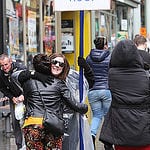
Crowe, P, 2015 Can We Hug Taken 7th May 2015
The costume worked well it kept us looking the same and in unison. However one member of the group did take off their poncho which i feel did detract from the performance slightly as it stopped us all looking the same. The fact that the ponchos were clear and the other three members of the group kept theirs on did soften the blow slightly.
Site specific performance has taught me that performance doesn’t need to take place on a stage, ‘all the worlds a stage’ (shakespeare, 1623) I now have an appreciation for the use of site and space as an influence for performance, Site specific performance allows you to discover a site making a performance that has more depth as it takes inspiration from the surroundings and the history of your site.
Works Cited
Etchells, T. (1999) Certain Fragements. London: Routledge.
Govan, (2007). Between Routes and Roots. Performance, Place and Diaspora. 136-143.
Hancock,S (2012) Contemporary Walking Practices and the Situationist International: The Politics of Perambulating the Boundaries Between Art and Life. Contempory Theatre Review, Vol. 22 Issue 2, p237-250. 14p.
London.Gov (2009) Fourth Plinth [online] https://www.london.gov.uk/priorities/arts-culture/fourth-plinth[accessed on 10th may 2015]
Persighetti, S. and Smith, P. (2011) A Sardine Street Box of Tricks. Plymouth: Blurb Inc.
Sooke, A. (2009) Antony Gormley’s Fourth Plinth, Trafalgar Square. The Telegraph, 26 Feb. [Accessed Online] at: http://www.telegraph.co.uk/culture/4838343/Antony-Gormleys-Fourth-Plinth-Trafalgar-Square.html
Apted,M, Fergurson, R. De Salvo, D. (1999) Gillian Wearing. London: Phaidon Press.
emily cartwright (2015) signs 1 [Online Video] Available from https://www.youtube.com/watch?v=lSb6UobOszg [accessed 12 May 2015]
Dominique Gent (2015) Site Specific Observation Video [Online Video] https://youtu.be/CVtcgAIdgnc [accessed on 12th may 2015]
P, Crowe (2015) Lincoln performing arts Flickr
The Guardian (2015) The Fourth Plinth: the story so far [Online] http://www.theguardian.com/artanddesign/2009/jul/07/fourth-plinth-one-and-other [Accessed 13th may 2015]
Tate, (1993) Gillian Wearing OBE. [Online image] London: Tate. Available from: http://www.tate.org.uk/art/artworks/wearing-im-desperate-p78348
